World History
 |
 |
 |
 |
 |
 |
 |
The Carmelite Order - I
Protected by Our Lady for Centuries
“My orders do not admit contradiction or delay. So that you might have faith in my words, know that your judges, who are the enemies of my religion [=Order], will feel the vengeance of God this very night and will die simultaneously a sudden death.”
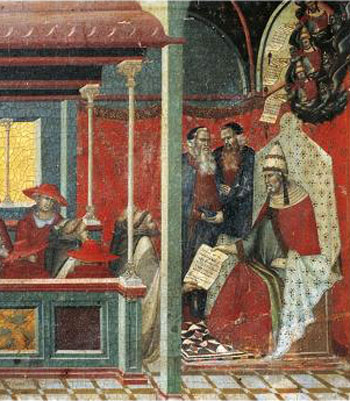 The Holy Virgin spoke these impressive words in a vision to Pope Honorius III in 1226, ordering him to approve and protect the Rule of the Carmelite Order, that is, the Order of Our Lady of Mount Carmel.
The Holy Virgin spoke these impressive words in a vision to Pope Honorius III in 1226, ordering him to approve and protect the Rule of the Carmelite Order, that is, the Order of Our Lady of Mount Carmel.
The next day, January 30, Honorius III learned of the deaths of the judges whom he had convoked to resolve the case regarding the approval of the Carmelite Order. The Pope then called the Carmelite religious to appear before him, embraced them warmly, and proceeded to compose the Bull Ut vivendi normam, which confirmed their Rule. The institution was definitively approved on this date.
The sons of Carmel gave thanks upon learning of this prodigy and the extraordinary protection of the Virgin Mary over their Order. The remembrance of this event was perpetuated by a feast, instituted by that same Pontiff at the request of St. Simon Stock, who was then Vicar General of the Carmelites in the West. This is the solemn feast day of Our Lady of Mount Carmel, recorded in the liturgical calendar on July 16.
Elias the Prophet, Founder of the Carmelites
Mount Carmel is a beautiful mountain situated in Palestine. It makes up part of the mountain range in Libya that towers over the Bay of St. John of Acre in the Mediterranean. Situated between Galilee and Samaria, it is approximately 10.5 miles from Nazareth, rising over 1,700 feet above sea level.
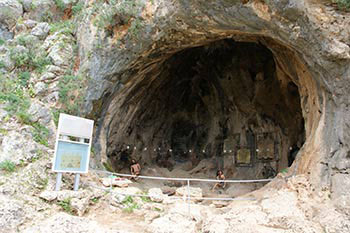
 In Hebrew Carmel means ‘Vineyard of God,’ or ‘Flowering Plain.’ The Arabs call it the Mountain of St. Elias, since this was where the holy Prophets Elias and Eliseus lived in the time of the Old Testament. The caves they inhabited and the fountain of water that sprang forth from the ground upon the command of Elias can still be seen there.
In Hebrew Carmel means ‘Vineyard of God,’ or ‘Flowering Plain.’ The Arabs call it the Mountain of St. Elias, since this was where the holy Prophets Elias and Eliseus lived in the time of the Old Testament. The caves they inhabited and the fountain of water that sprang forth from the ground upon the command of Elias can still be seen there.
The Prophet Elias, born in the year 980 BC, put to death 450 false prophets of the false god Baal on the shores of the River Kishon, which runs at the foot of Mount Carmel. The false priests of that pagan god had seduced the people of Israel, causing them to fall into idolatry. By the command of Elias, the skies released no water for a period of three years. The earth, deprived of rain and dew, became as barren and sterile as the heart of a sinner.
After divine justice sanctioned this momentous, solemn execution of the enemies of the faith, a miraculous event took place, which, according to exegetics, signifies the sublime figure of Mary Most Holy, who would only come to the world centuries later.
After Elias had taken up his sword and slain the priests of Baal, he told Ahab, the King of Israel, “Go up, eat and drink, for there is a sound of the rushing of rain.”
Then, he climbed to the top of Mount Carmel and prostrated himself before the Lord. After praying, the Prophet said to his servant, “Go up now, and look toward the sea.” The servant went, and after contemplating the calmness of the waters, he returned and told the Saint, “There is nothing.” Elias commanded him to return and do the same seven times.
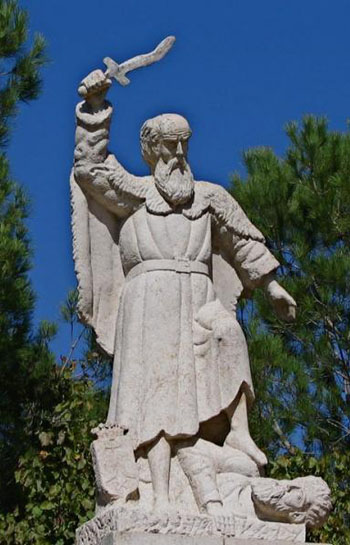 The seventh time, the servant reported, “Behold, there arises a little cloud out of the sea, like a man’s hand.” Then the Prophet said: “Go up and say to Ahab: Prepare thy chariot and go down, lest the rain prevent thee.” And Ahab, frightened, looked about him and the sky grew dark and violent, and a great storm arose.” (I Kings 18: 41-46 )
The seventh time, the servant reported, “Behold, there arises a little cloud out of the sea, like a man’s hand.” Then the Prophet said: “Go up and say to Ahab: Prepare thy chariot and go down, lest the rain prevent thee.” And Ahab, frightened, looked about him and the sky grew dark and violent, and a great storm arose.” (I Kings 18: 41-46 )
The Office of Our Lady of Mount Carmel explains that the cloud that rose up from the sea was symbol of the Virgin Mary. And just as the cloud that rose up from the sea did not bear the weight and burden of water, so also did Mary rise up from the decadent human race corrupted with original sin, she herself being not the least bit tainted by sin. Thus has the doctrine of the Immaculate Conception always been specially venerated in the Carmelite Order.
Elias took Eliseus as his disciple and successor and many faithful Israelites gathered around him. It was upon Mount Carmel that the holy Prophet founded his Order, with the aim of forming men of zeal to fight against Baal and his false priests and prophets.
Our Lady visits Mount Carmel
Nazareth, the city where Mary spent the greater part of her life, is near Mount Carmel. A pious tradition narrates that, upon returning from Egypt, the Holy Family stayed in the cave of this School of the Prophets for several days. During the time she lived in the city, Our Lady would delight in visiting the foot of the mountain to speak with the hermits and instruct them in the mysteries of the Faith and the rule of perfection.
According to this same tradition, many sons of Elias listened to the preaching of St. John the Baptist and were baptized by him. On the day of Pentecost, they were also present when the Apostles spoke in tongues and began to perform miracles in the name of Jesus. They believed the Gospel of Christ and had a most tender affection for Our Lady, whom they had the joy of seeing and knowing. They united themselves with the Apostles, preaching in Judea and Samaria.
On Mount Carmel, they erected a small chapel in honor of the Blessed Virgin Mary. This was, undoubtedly, the first church dedicated to Our Lady. There they gathered each day to sing praises to the Mother of God.
The faithful who flocked there began to call themselves Brothers of the Holy Virgin, a glorious title that was preserved in the Order and recognized by the Pope. Moreover, Blessed Urban II granted special indulgences to those who called the Carmelites the Brothers of the Holy Mother of God, Mary of Mount Carmel.
Carmelites revived by the Crusaders
The Carmelites suffered greatly during the Roman persecutions and the Muslim conquest of the Holy Land. Their martyrs were numerous. They were even obliged for a certain period of time to abandon their religious habit. It seemed as if the Carmelite Order was losing the last vestiges of its glory and beauty. During this period, the sons of the Prophet Elias lived a hermetical life of recluse.
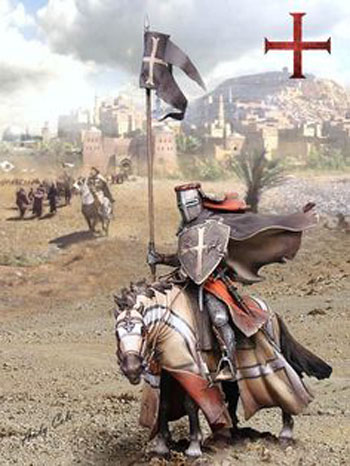
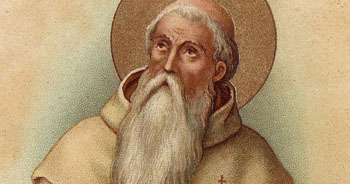 Freed by the swords of the Catholic knights, they joined together anew under the authority and spiritual direction of St. Berthold of Calabria, son of the Count of Limoges, who was a great crusader and defender of the city of Antioch.
Freed by the swords of the Catholic knights, they joined together anew under the authority and spiritual direction of St. Berthold of Calabria, son of the Count of Limoges, who was a great crusader and defender of the city of Antioch.
After he received a vision of Christ denouncing the bad life of the soldiers, the Count abandoned his sword, shield and armor and exchanged them for spiritual arms, embracing the ascetic life at the foot of Mount Carmel. He built a small chapel there and gathered a community of hermits who lived at his side in imitation of the Prophet Elias.
Other Crusaders followed his example and branches of the Order were established in various countries of Christendom, led by St. Cyril, St. Angelus of Jerusalem and St. Simon Stock. With the fall of the Roman Kingdom in Jerusalem, the Carmelite Order ran the risk of being extinguished. But, instead, it was Our Lady’s design that it should spread throughout the whole world. The Generals of the Order, St. Berthold and St. Alan, send emissaries to Cyrus, Sicily, Germany and England.
St. Louis IX, King of France, who was saved from shipwreck through the intercession of Our Lady of Mount Carmel, received the hospitality of the Carmelite monks. In retribution, he built them a monastery in Paris, the first of many to follow. However, being a new institution in the West, the Carmelite Order was the object of much opposition and persecution.
During the Fourth General Lateran Council in 1215, Innocent III established that no new religious orders could be founded without Papal approval. In 1205, 10 years prior to the Council, St. Albert, Patriarch of Jerusalem, had granted a written Rule to the Carmelites in the Pope’s name, acting as his legate. Considering the ancient origin of the Carmelite Order, as well as the elaboration and sanction of the Rule of the Patriarch and decree of Innocent III, fears for the suppression of this religious Order were allayed.
However, the unexpected expansion of the Carmelite Order provoked the wrath of the Devil, who stirred up men animated by an indiscreet zeal. Under the pretext of adhering to the laws of the Church and conciliar norms, an attack was launched against the Carmelite Order with the aim of abolishing it.
Pope Honorius III had succeeded Innocent III in the papal office, and this Supreme Pontiff named two judges whom he believed to be supporters of the Order to examine the case. These two persons, however, were not neutral, and they worked to delay the process, multiplying the difficulties. The delays continued for 10 years until Our Lady, at the request of St. Simon Stock and all the Carmelites, took the matter into Her own sublime hands.
After the chastisement of the two judges of the Roman Curia with their unexpected deaths the Carmelites were able to enjoy a time of peace.
Continued
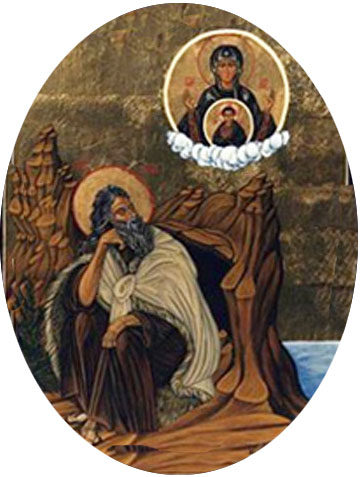

Posted July 26, 2019

Pope Honorious calls the Carmelites to approve their rule and dismisses the two judges
The next day, January 30, Honorius III learned of the deaths of the judges whom he had convoked to resolve the case regarding the approval of the Carmelite Order. The Pope then called the Carmelite religious to appear before him, embraced them warmly, and proceeded to compose the Bull Ut vivendi normam, which confirmed their Rule. The institution was definitively approved on this date.
The sons of Carmel gave thanks upon learning of this prodigy and the extraordinary protection of the Virgin Mary over their Order. The remembrance of this event was perpetuated by a feast, instituted by that same Pontiff at the request of St. Simon Stock, who was then Vicar General of the Carmelites in the West. This is the solemn feast day of Our Lady of Mount Carmel, recorded in the liturgical calendar on July 16.
Elias the Prophet, Founder of the Carmelites
Mount Carmel is a beautiful mountain situated in Palestine. It makes up part of the mountain range in Libya that towers over the Bay of St. John of Acre in the Mediterranean. Situated between Galilee and Samaria, it is approximately 10.5 miles from Nazareth, rising over 1,700 feet above sea level.

The cave of Elias in the mountains of Carmel, seen below on the horizon

The Prophet Elias, born in the year 980 BC, put to death 450 false prophets of the false god Baal on the shores of the River Kishon, which runs at the foot of Mount Carmel. The false priests of that pagan god had seduced the people of Israel, causing them to fall into idolatry. By the command of Elias, the skies released no water for a period of three years. The earth, deprived of rain and dew, became as barren and sterile as the heart of a sinner.
After divine justice sanctioned this momentous, solemn execution of the enemies of the faith, a miraculous event took place, which, according to exegetics, signifies the sublime figure of Mary Most Holy, who would only come to the world centuries later.
After Elias had taken up his sword and slain the priests of Baal, he told Ahab, the King of Israel, “Go up, eat and drink, for there is a sound of the rushing of rain.”
Then, he climbed to the top of Mount Carmel and prostrated himself before the Lord. After praying, the Prophet said to his servant, “Go up now, and look toward the sea.” The servant went, and after contemplating the calmness of the waters, he returned and told the Saint, “There is nothing.” Elias commanded him to return and do the same seven times.

A statue commemorating Elias slaying the false priests on Mount Carmel
The Office of Our Lady of Mount Carmel explains that the cloud that rose up from the sea was symbol of the Virgin Mary. And just as the cloud that rose up from the sea did not bear the weight and burden of water, so also did Mary rise up from the decadent human race corrupted with original sin, she herself being not the least bit tainted by sin. Thus has the doctrine of the Immaculate Conception always been specially venerated in the Carmelite Order.
Elias took Eliseus as his disciple and successor and many faithful Israelites gathered around him. It was upon Mount Carmel that the holy Prophet founded his Order, with the aim of forming men of zeal to fight against Baal and his false priests and prophets.
Our Lady visits Mount Carmel
Nazareth, the city where Mary spent the greater part of her life, is near Mount Carmel. A pious tradition narrates that, upon returning from Egypt, the Holy Family stayed in the cave of this School of the Prophets for several days. During the time she lived in the city, Our Lady would delight in visiting the foot of the mountain to speak with the hermits and instruct them in the mysteries of the Faith and the rule of perfection.
According to this same tradition, many sons of Elias listened to the preaching of St. John the Baptist and were baptized by him. On the day of Pentecost, they were also present when the Apostles spoke in tongues and began to perform miracles in the name of Jesus. They believed the Gospel of Christ and had a most tender affection for Our Lady, whom they had the joy of seeing and knowing. They united themselves with the Apostles, preaching in Judea and Samaria.
On Mount Carmel, they erected a small chapel in honor of the Blessed Virgin Mary. This was, undoubtedly, the first church dedicated to Our Lady. There they gathered each day to sing praises to the Mother of God.
The faithful who flocked there began to call themselves Brothers of the Holy Virgin, a glorious title that was preserved in the Order and recognized by the Pope. Moreover, Blessed Urban II granted special indulgences to those who called the Carmelites the Brothers of the Holy Mother of God, Mary of Mount Carmel.
Carmelites revived by the Crusaders
The Carmelites suffered greatly during the Roman persecutions and the Muslim conquest of the Holy Land. Their martyrs were numerous. They were even obliged for a certain period of time to abandon their religious habit. It seemed as if the Carmelite Order was losing the last vestiges of its glory and beauty. During this period, the sons of the Prophet Elias lived a hermetical life of recluse.

St. Berthold, a crusader at Antioch who revived the Carmelite Order at Mount Carmel

After he received a vision of Christ denouncing the bad life of the soldiers, the Count abandoned his sword, shield and armor and exchanged them for spiritual arms, embracing the ascetic life at the foot of Mount Carmel. He built a small chapel there and gathered a community of hermits who lived at his side in imitation of the Prophet Elias.
Other Crusaders followed his example and branches of the Order were established in various countries of Christendom, led by St. Cyril, St. Angelus of Jerusalem and St. Simon Stock. With the fall of the Roman Kingdom in Jerusalem, the Carmelite Order ran the risk of being extinguished. But, instead, it was Our Lady’s design that it should spread throughout the whole world. The Generals of the Order, St. Berthold and St. Alan, send emissaries to Cyrus, Sicily, Germany and England.
St. Louis IX, King of France, who was saved from shipwreck through the intercession of Our Lady of Mount Carmel, received the hospitality of the Carmelite monks. In retribution, he built them a monastery in Paris, the first of many to follow. However, being a new institution in the West, the Carmelite Order was the object of much opposition and persecution.
During the Fourth General Lateran Council in 1215, Innocent III established that no new religious orders could be founded without Papal approval. In 1205, 10 years prior to the Council, St. Albert, Patriarch of Jerusalem, had granted a written Rule to the Carmelites in the Pope’s name, acting as his legate. Considering the ancient origin of the Carmelite Order, as well as the elaboration and sanction of the Rule of the Patriarch and decree of Innocent III, fears for the suppression of this religious Order were allayed.
However, the unexpected expansion of the Carmelite Order provoked the wrath of the Devil, who stirred up men animated by an indiscreet zeal. Under the pretext of adhering to the laws of the Church and conciliar norms, an attack was launched against the Carmelite Order with the aim of abolishing it.
Pope Honorius III had succeeded Innocent III in the papal office, and this Supreme Pontiff named two judges whom he believed to be supporters of the Order to examine the case. These two persons, however, were not neutral, and they worked to delay the process, multiplying the difficulties. The delays continued for 10 years until Our Lady, at the request of St. Simon Stock and all the Carmelites, took the matter into Her own sublime hands.
After the chastisement of the two judges of the Roman Curia with their unexpected deaths the Carmelites were able to enjoy a time of peace.
Continued

Elias sees the cloud representing Our Lady

Posted July 26, 2019
______________________
______________________
 Volume I |
 Volume II |
 Volume III |
 Volume IV |
 Volume V |
 Volume VI |
 Volume VII |
 Volume VIII |
 Volume IX |
 Volume X |
 Volume XI |
 Special Edition |


